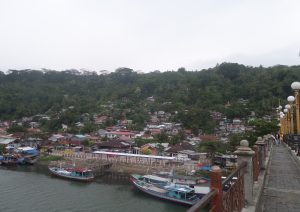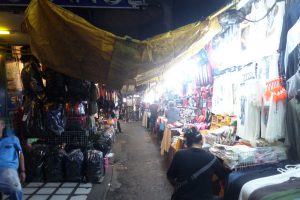About Samarkand – why should you go?
Samarkand is definitely one of the highlights of not only a trip to Uzbekistan, but any trip to Central Asia. It is one of the oldest cities of the world. It changed hands during its history innumerable times. Alexander the Great was one of the leaders who conquered the city, and he is famously supposed to have said: “Everything I was told about Marakand (the Greek name of Samarkand) is true. Except that it is much more beautiful than I could ever have imagined”.
Unfortunately, there is nothing left of what he could possibly see in the city, since Genghis Khan was apparently not impressed that much (was he ever impressed by anything at all, I wonder?), and he completely destroyed Samarkand. This is possibly one of the reasons why there is nothing in the city older than the 13th century, but the main sights were built in the 14th and 15th centuries. (See the sights below.)
What makes Samarkand – as indeed, any other place in Uzbekistan – a wonderful place to visit is not only the sights, but also its people. You will find friendly and helpful locals (almost) everywhere. If you speak a little Russian (or Uzbek), you will have a much more enjoyable time with the locals, since not many of them are likely to speak English very well.

How to get to Samarkand
Should you prefer to start your Uzbekistan trip in Samarkand, there are Turkish Airlines flights from Istanbul to Samarkand, though they seem to be much more expensive than flights to Tashkent, the capital. But even if money is no object for you, Tashkent is worth visiting in its own right. Most people either start in Tashkent and continue to Samarkand, Bukhara and Khiva, or do the reverse and from Tashkent, they fly to Khiva, and then go to Bukhara and Samarkand, before ending their trip in Tashkent.
Whether you are coming from Tashkent or Bukhara, there is an excellent train connection to Samarkand. You can either choose the modern and very fast Afrosiyob trains or the more traditional and slower trains. The former seems to be very popular, so book ahead if you can (use the English language official website). A ticket for the fast train from Tashkent costs about 100.000 sums, but there are several trains daily, and prices may differ.

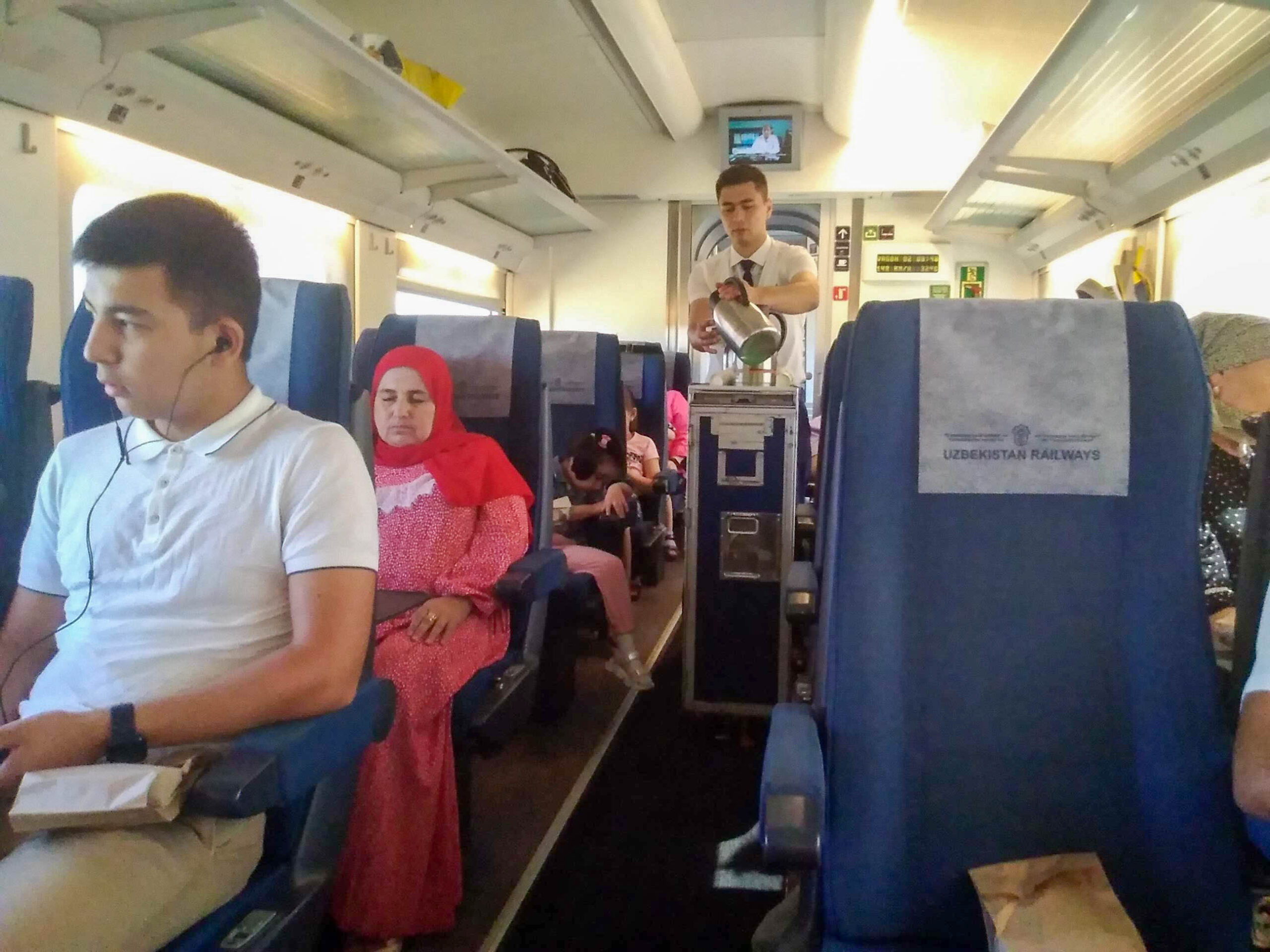
You can also use the long distance minibuses, the so-called marshrutkas, which are not overly comfortable, but they are cheap. Some people also opt for using a taxi, which may be a good idea if there are three or four of you, but the price may be too high if you are a budget solo traveller.
Whether you arrive at the airport or the railways station, you will be just a short taxi ride away from the city centre. This will not stop taxi drivers from trying to charge you at least four or five times more than the usual cost, which is maximum 20.000 sums. But if you have the Yandex app, you will have no problem: it is the local equivalent of Uber/Grab, and works very much the same way. You order the taxi in the app, it calculates the final price, and you can pay by cash or card.
Recommended sights in Samarkand
The Registan

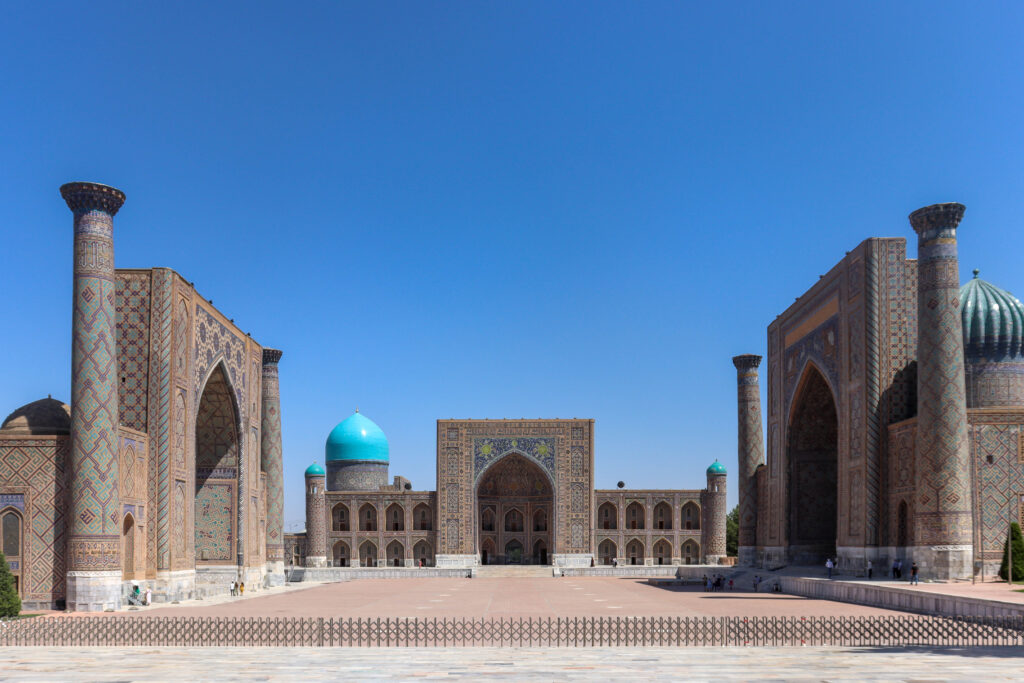
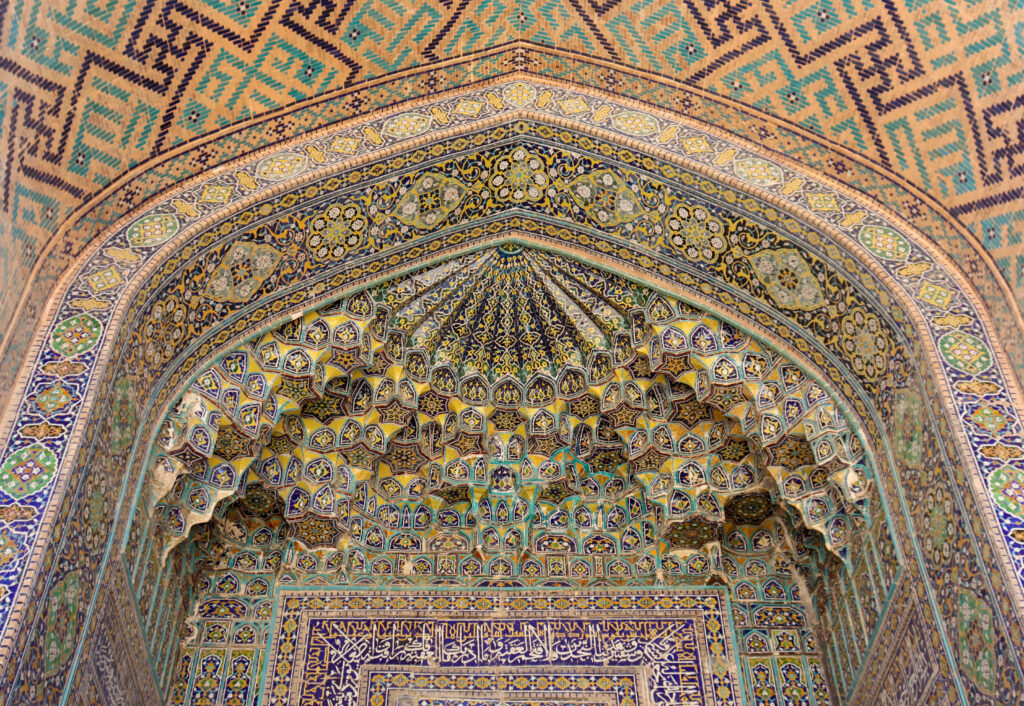
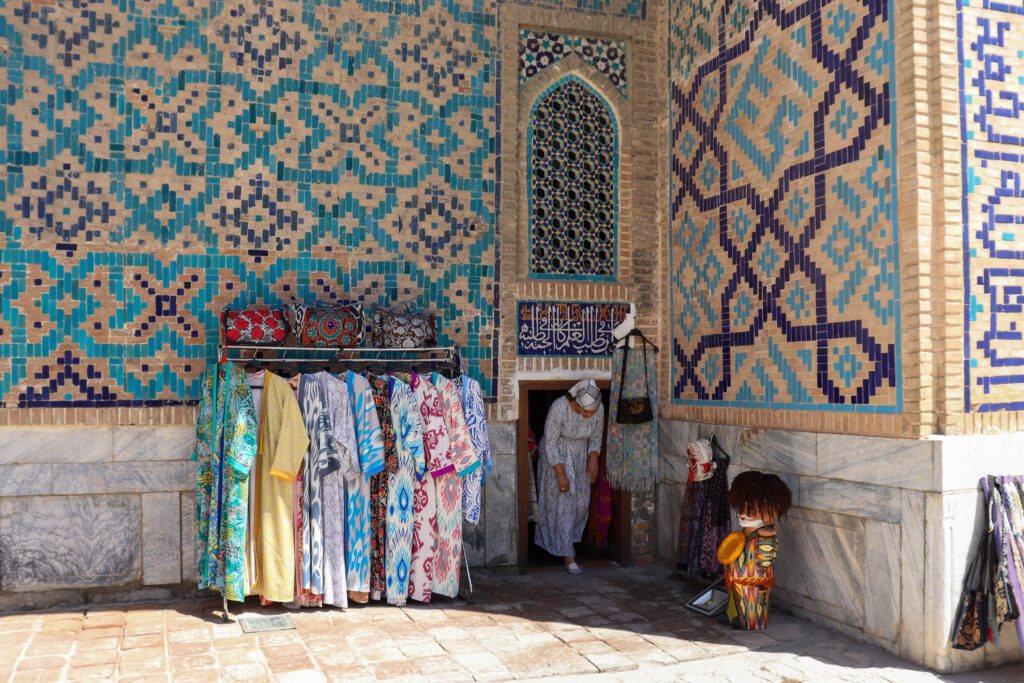
I took a taxi from the Samarkand railway station to my guesthouse near the Registan. I had a very talkative driver (we communicated in Russian, English is not commonly spoken in Uzbekistan), and while we were chit-chatting, he suddenly casually said to me, oh, by the way, this is the Registan on the right. And I looked there, and was so shocked by its beauty (yes, even seen only from the car), that I couldn’t help crying out loudly: Oh, my god! Just why didn’t you warn me in advance?!
The most famous sight in Samarkand and Uzbekistan, and perhaps in the whole of Central Asia, is a square called The Registan (according to Wikipedia, it means “sandy place” in Persian).
The huge square is surrounded by three magnificent buildings on three sides. All three are madrasahs, i.e. Islamic schools where students used to live and study. Today, they are historical monuments, and the tiny student quarters are currently home to small shops selling T shirts, scarves and fridge magnets.
The three madrasahs were built at different times, the earliest is the Ulugh Beg madrasah on the western side (or the left), built in 1417-1420; the Sher-dor madrasah on the right was built in 1619-1636, and the latest addition is the Tilya-Kori madrasah in the middle, built between 1646-1660. All three have their own exciting stories, but in this post, I am not going to include them (Wikipedia is your friend, as always).
Entrance fee is 50.000 sums. Guidebooks and other sources will say that the ticket is valid for the whole day, and that you can freely return during the day several times, but this is no longer the case. At the beginning of the pandemic, they installed machines to check the QR code on the ticket, and with this, the one-day validity was gone. You can, however, spend as much time after you enter the square, as you like.
It is worth looking at the Registan in different part of the day under different light conditions, so I strongly recommend returning as many times as possible, including during the night. According to several sources, there might be light shows in the evening, but I never saw one, but you may be luckier.
There is a park and a square to the east of the Registan, which is also a good place to stroll, especially in the evening, when you may see some open air concert or some other show.
Bibi Khanym Mosque
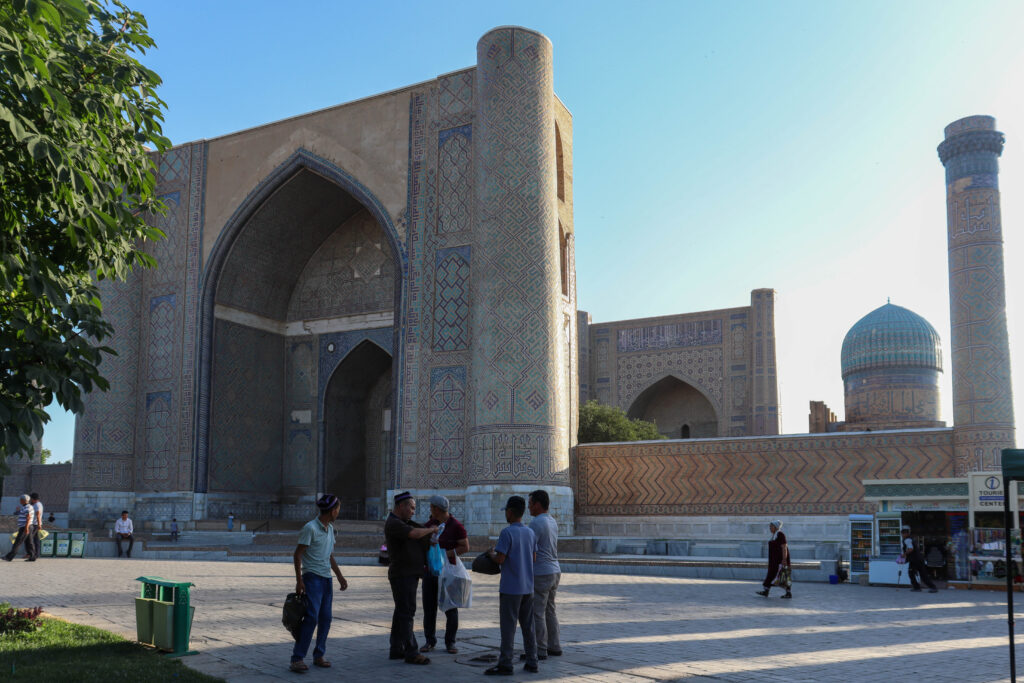
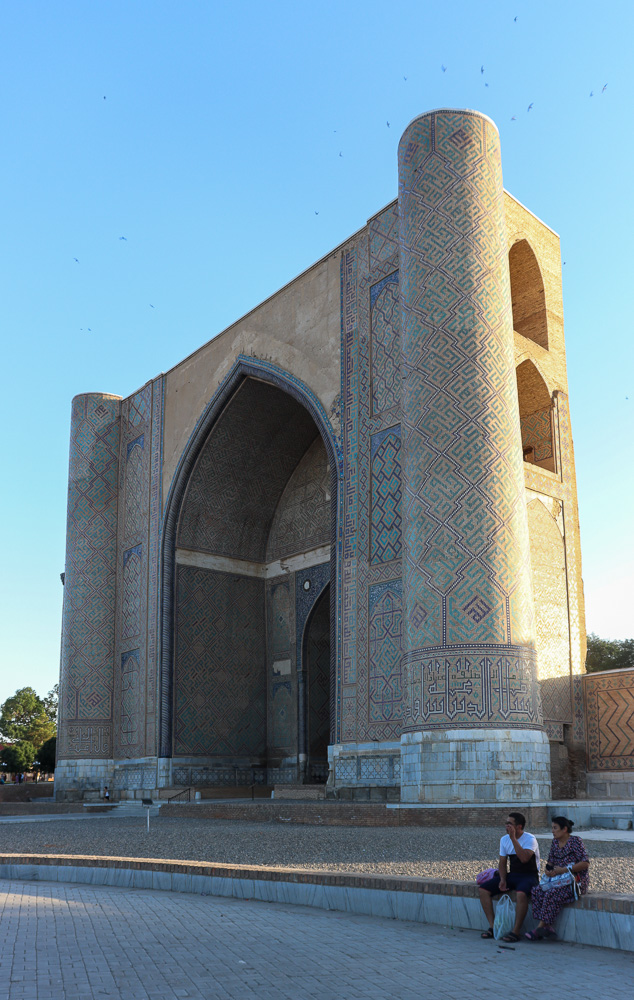
This mosque is one of the most famous in the city, but a lot of people, like myself, decide to look at it from the outside only (entrance fee 30.000), perhaps because we have seen so many similar buildings from the inside already. But if you don’t need to save money, you can just support the mosque by buying your ticket and have a look inside.
The mosque was built by Timur shortly after 1400, and is one of the largest mosques, as well as one of the greatest buildings from the Timurid era. It was reconstructed by the Soviets in the 20th century, and today, you can appreciate its full beauty.
The legend behind the mosque is also interesting. Bibi Khanym was Timur’s Chinese wife, and while Timur was away doing his conquering as usual, Bibi decided to have a grandiose mosque built as a gift to her husband, Timur. Construction began, and was almost finished shortly before Timur was expected to return, but the architect had fallen in love with Bibi Khanym so madly that he said he wouldn’t finish the mosque unless he gets a kiss from Bibi Khanym. Now what coulld she do, really?! She gave let the architect kiss her. But alas, the kiss was so vehement, that it left a mark on Bibi Khanym’s face. Timur returned from his “adventures”, and shortly noticed the mark of the kiss on his wife’s face. When he learnt about what had happened, he promptly sentenced the architect to death. (He did nothing to his wife though, but then, this is what you should always expect from such stories.)
Shah-i-Zinda
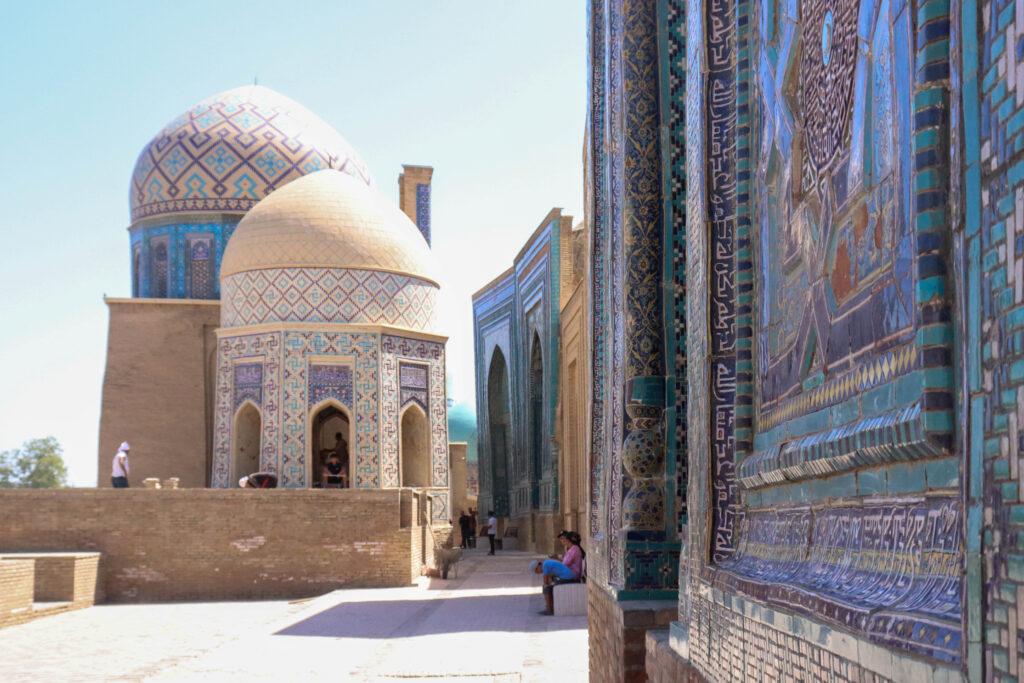
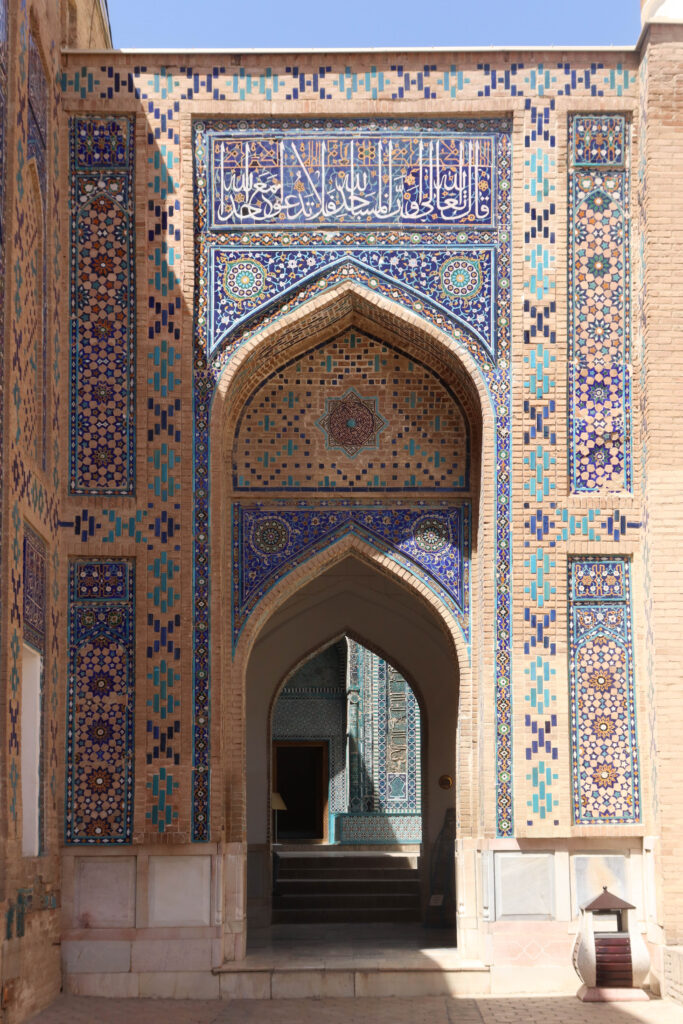

Another must-see when you are in Samarkand, so even if you are pressed for time, you definitely should visit this place. Shah-i-Zinda is a mausoleum complex: you will see a large number of majestically decorated burial places here, some of which serve as the final resting place of anonymous people – which was really surprising for me personally, because even the anonymous ones look pretty, and you would expect that they were built for someone important.
In any case, a walk along the narrow lane between the mausoleums will definitely be a memorable experience. When I was there, I only a saw a couple of other visitors, and I am sure you can even find a time period when there are no other people around – should you want to take photos without other people around these wonderful buildings.
To get to Shah-i-Zinda from the centre, take the beautiful pedestrian street (Tashkentskaya street) from the Registan, which leads you past Bibi Khanym and past the market. Walk over the small covered bridge, where you will see the Hazrat Khizr mosque, which is also an important sight (even if for me, it was not am outstanding experience). To get to Shah-i-Zinda from the mosque, turn right to the east. You will also see a sign. Next to Shah-i-Zinda, there is a cemetery, which you may also have a look at. Entrance fee to Shah-i-Zinda is 30.000 sums. (Some sources say that you may have free access to the mausoleums from the cemetery. Even if this is the case, I recommend that you should use the official entrance and pay this small fee to support their maintenance.)
Gur-i Amir Mausoleum
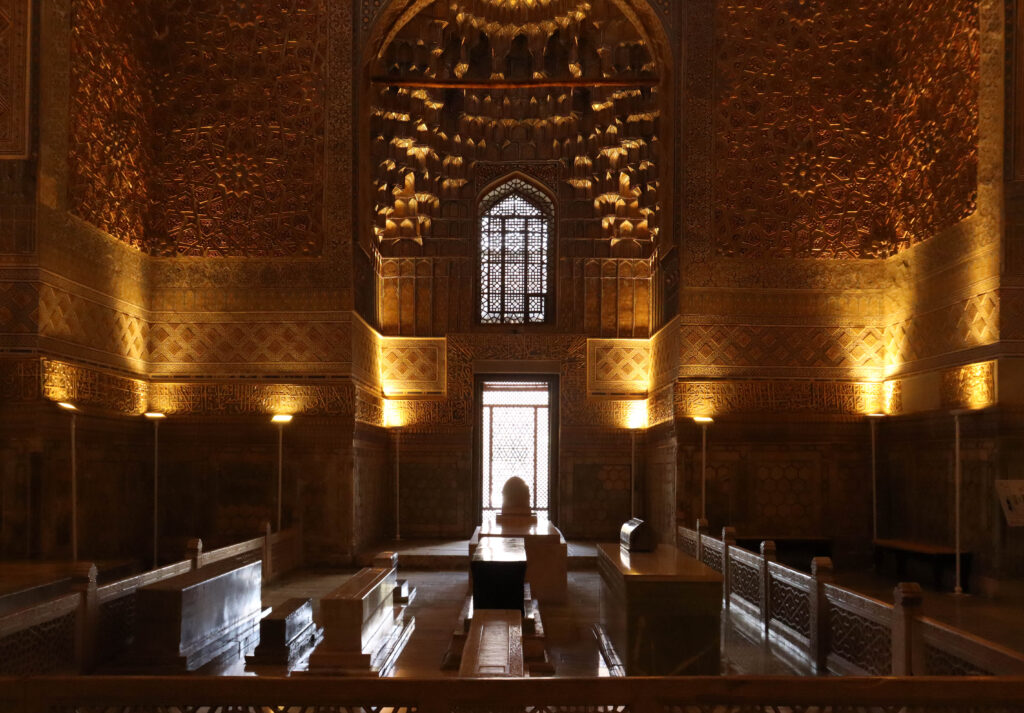
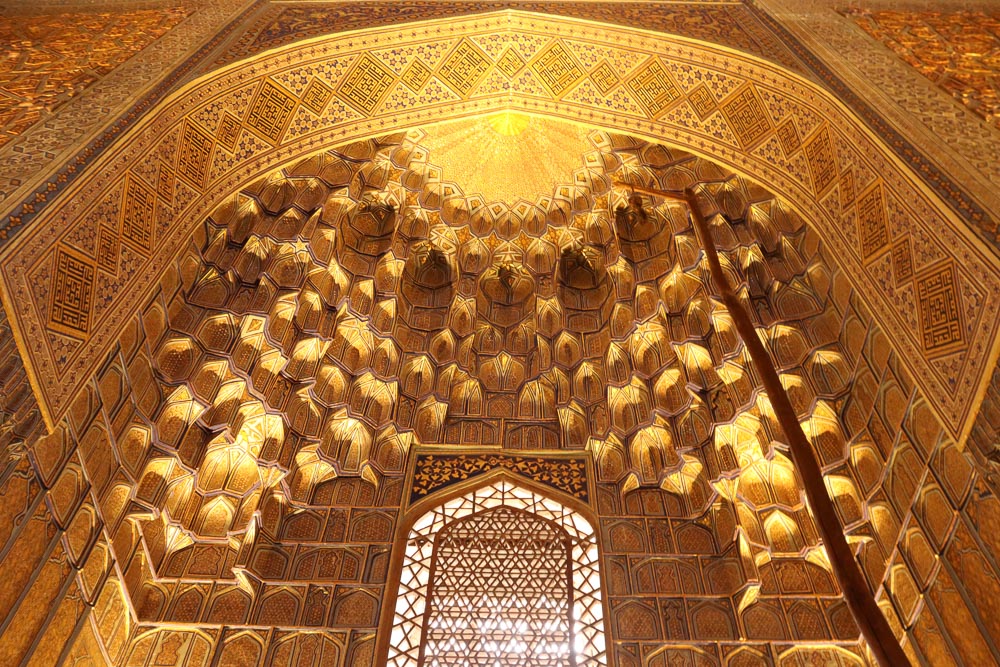
It is Timur’s final resting place, and is sometimes called Gur-e-Amir or Guri Amir, among others. For me, it was also one of the highlights of my Samarkand trip: looking at the ornamental interior is worth the 30.000 sums you pay for the entry ticket. It is also a small museum with information in English too, but the mausoleum itself is very small. When I was there, there were a few people visiting, but I waited for some time for them to leave, so that I could enjoy the experience all to myself.
You can easily walk to Gur-i Amir from the Registan area, there is a nice park along the way, but you can also use a taxi for not more than 15 or so thousand sums.
If you have more time…
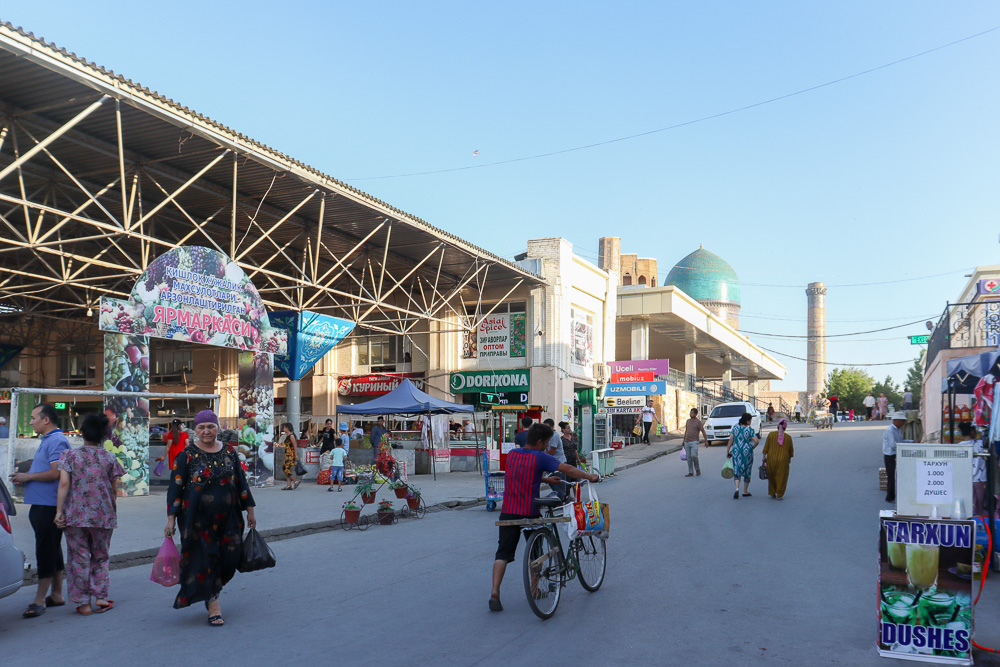
There is a famous local market next to the Bibi Khanym mosque, where you can also shop for souvenirs, and there is also a restaurant, Kyzyl chaixona, which serves local food, which unfortunately, was closed when I wanted to have an early dinner there.
The Afrasiyab settlement is also a place of interest for those who like to look at ruins of old settlements, but may not be overly interesting for others.
A popular place that you can visit in a day trip is Shahrisabz, the former seat of the Timurid Empire, and the birthplace of Timur himself. I decided not to visit, because I didn’t have very much time, but most people say you don’t necessarily miss too much if you don’t go. Other travellers reported that the day trip cost them 70-100 USD, which I think is too much by Uzbek standards (and by my budget, too), but if you are not a solo traveller, then the price could be OK.
Food and drink

For me, Samarkand did not prove to be an outstanding culinary experience. In fact, I was sometimes struggling to find an acceptable place to eat – at least in the historical centre, where I was staying. Yes, there were a few restaurants, but when I looked a their reviews on Google Maps, I said to myself it is better not to try my luck at any of those places.
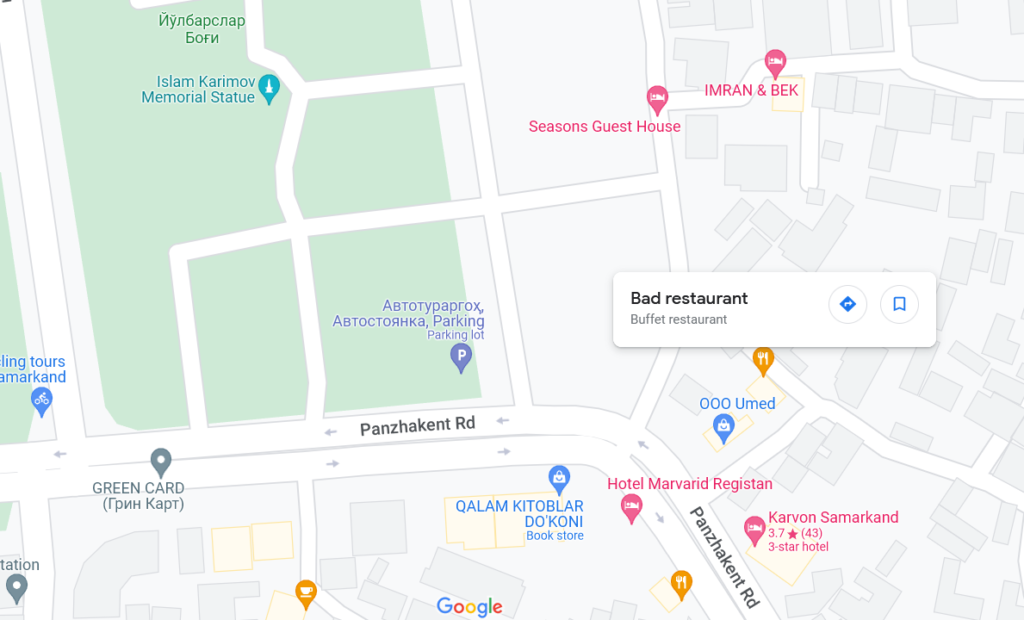
(A screenshot from Google Maps)
I did find one restaurant which, according to the reviews, was supposed to be fine. It’s called Historikal, and although there are very few reviews, all of them speak highly of the place. But unfortunately, the place is not nice at all, it is incredibly small, and there were very few options. I didn’t get a menu, but when another tourist showed up, she got one. Anyway, the food was OK, but overpriced, and the staff didn’t seem to care much at all.
After that, I decided to eat my dinners in a small eatery near the Registan (see the photo above with the Uzbek people who invited me over to their table). I didn’t really care much though. If you do, and want to eat good food, I suppose you must jump in a taxi, leave the touristy area, and find something good further away – after all, Samarkand is a large city with more than half a million inhabitants, so there must be good dining options there. You may also try your luck along Tashkentskaya street, the pedestrian street leading from the Registan to Shah-i-Zinda and the market, they all look nice, but I never tried any of them.
Where to stay in Samarkand?
Samarkand is full of small and even smaller guesthouses, and most of them are highly rated on the booking sites and on Google maps.
I chose Hotel 129, which is a family guesthouse with a nice inner courtyard where you have breakfast. Breakfast is normally included in the price in Uzbekistan, but the quality, the options and the quantity varies a lot. Hotel 129 had decent breakfasts, and you also get free coffee and tea throughout the day. I especially enjoyed it because I had the chance to meet other guests, and had really interesting conversations with most of them. This was true for other guesthouses in other cities of Uzbekistan too, so if you are like me, I strongly recommend you choose a small guesthouse rather than a large hotel.
Whichever guesthouse you choose, you are not likely to pay more than 40 USD a night (I paid 30 for a single use double with air-con). Most guesthouses are very near the main sights, which are walking distance from each other, so much so, that I never had to use a taxi anywhere except the railway station.
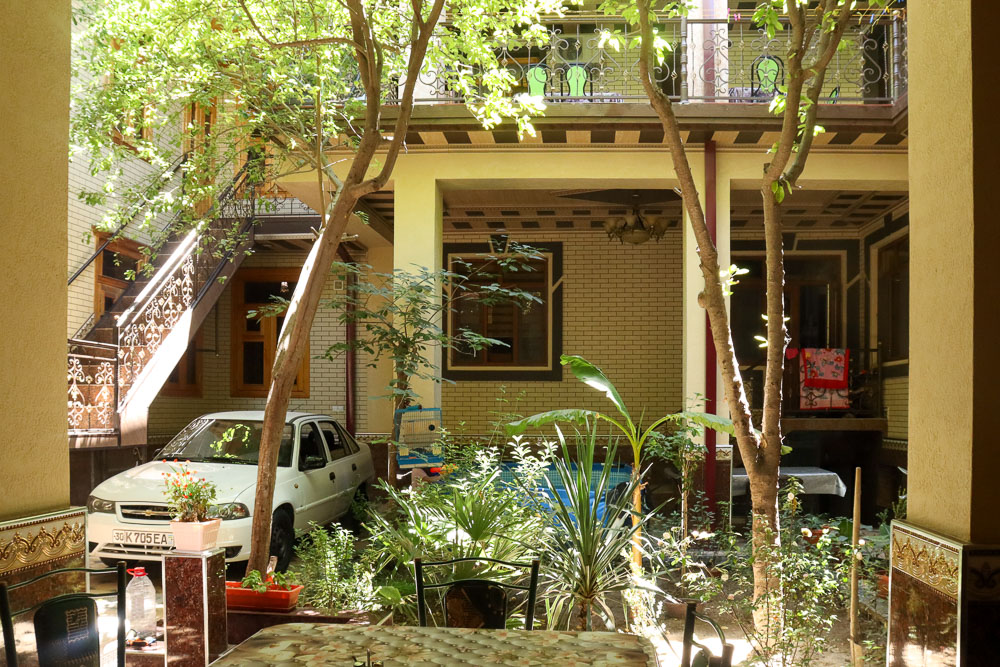
Where to go next?
Shakhrishabz is very near Samarkand, and you can do it in a day trip (half a day, actually). Costs of private transport seem to be rather highish by Uzbek standards/price levels, but if 70-100 USD is not a concern for you, and if time allows you should go and see the non-renovated sights, which may seem even more interesting for some, than the heavily renovated ones elsewhere. Otherwise, you don’t mis too much if you decide not to.
Most people, however, go either to Bukhara or back to Tashkent, if they are coming from Bukhara itself.


